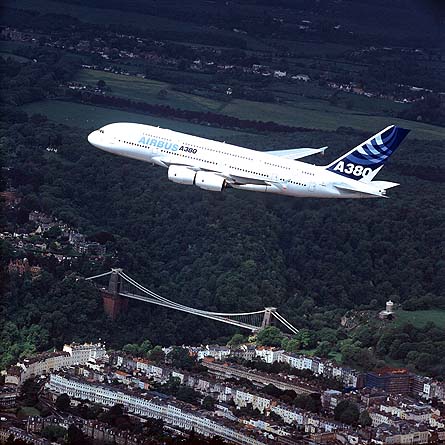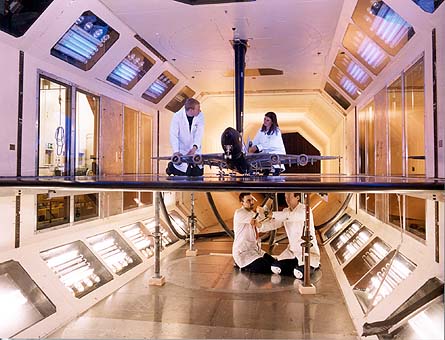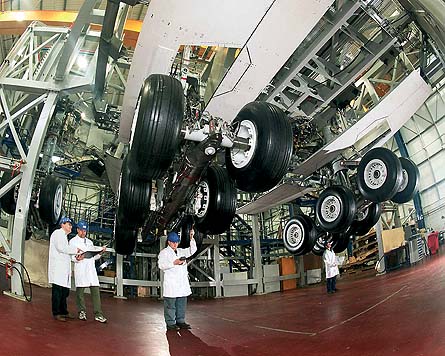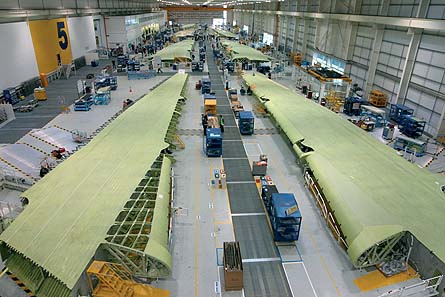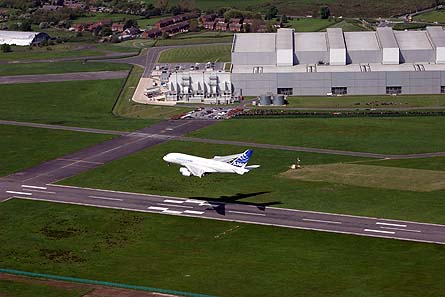By Max Kingsley Jones in Broughton & Filton
Despite BAE Systems’ decision to sell up, Airbus’s British managers are confident the UK can remain centre of excellence for carbonfibre wing production
|
|---|
| Every A380 wing starts its journey to Toulouse sailing along the River Dee on a barge |
Once home to the UK’s original Concorde partner – the Bristol division of British Aircraft Corporation – Filton has been the base for the UK’s Airbus business since British Aerospace became a 20% shareholder in what was then a European consortium in 1979 Filton assembled 10 of the 20 Concordes built over a decade from the late 1960s, and the plant has already delivered in excess of that number of wings for Concorde’s spiritual successor in European civil aircraft development, the Airbus A380 ultra-large airliner. And it is preparing to boost production of the huge assemblies to four a month.
With a workforce of around 13,000 people (including around 3,000 subcontractors), Airbus UK’s primary role within the airframer’s pan-European operation is as the designated “centre of excellence” for wing design and assembly. The company and its forebears have designed and built the wings for all Airbus aircraft since the original A300B. The UK’s responsibilities within Airbus have grown in recent years to include landing-gear systems and fuel systems integration, which has seen its parent invest in a series of major new facilities at Filton, including fuel systems and landing-gear test rigs, as well as a composites development centre.
Airbus UK also has a subcontract from Raytheon to build wings and fuselages for the Hawker 850 business jet. This work, which employs around 450 people, is a legacy from the days when BAe produced the Hawker’s predecessor, the 125, before selling the programme to Raytheon.
The entire division has an annual turnover of £1.5 billion ($1.88 billion), and its annual net exports are worth in excess of £1 billion.
But Airbus’s influence in the UK goes far beyond its 13,000-strong workforce, says Airbus UK managing director and general manager Iain Gray. “We generate 140,000 jobs directly and indirectly throughout the UK – there are some 400 UK companies employed on the A380 programme alone,” he says.
|
|---|
| Two icons of UK engineering – the A380 with it’s British-built wings flies over the Brunel designed Clifton suspension bridge near the Filton plant in Bristol |
Brian Fleet, who as Airbus UK’s senior vice-president and head of the wing centre of excellence is “responsible for all deliverables from the two Airbus UK plants”, puts it simply: “Airbus UK is the engine that powers the rest of the UK’s aerospace industry.”
According to Gray, the UK arm of Airbus is “the seventh-largest investor in the UK in research and development terms, and on a per capita basis it is in the top three”.
The workshare on Airbus programmes allocated to the UK has traditionally been around 20%, harking back to the original subcontract with Hawker Siddeley Aviation to design and build the A300’s wing. This shareholding later crystalised as the British Aerospace stake in Airbus when BAe became a full partner.
Wing workshare
|
|---|
| The UK has led the design of every Airbus wing |
|
| Landing-gear systems fall within the UK’s responsibility |
“That workshare is no longer relevant in an absolute sense,” says Gray. “The wing represents approximately a 20% share of development at an aircraft level – but this can vary with the size of the aircraft. The concept of ‘centres of excellence’ within Airbus is an industrially optimised solution around capability and efficiency, rather than around artificial sharings.”
Wing design and some manufacturing is carried out at Filton, which has a workforce of 5,800 people, while a further 6,600 work at Broughton on the Wales/England border just west of Chester, where wing final assembly is undertaken, as well as the Raytheon subcontract. “We’ve got 4,300 blue-collar workers at Broughton, making it the largest manufacturing site in Airbus and probably the UK,” says Fleet.
|
|---|
| Broughton equips twin-aisle aircraft wings, but Airbus Deutschland carries out installation of moving surfaces in Bremen |
He adds that Airbus has invested “in excess of €2 billion” in the UK division since the beginning of this decade, as facilities have been expanded to cope with increased production and new products like the A380 and A400M military airlifter – the latter having its wing assembly line in Filton. “The only other sectors in the UK with that level of investment are the pharmaceutical and petrochemical industries,” says Fleet. He adds that his budget this year is “€2.4 billion, covering serial programmes and non-recurring costs”.
Over £500 million has been invested in the UK to cater for the A380, and the overall expansion across the Broughton and Filton plants as Airbus output has grown has seen the employee headcount rise by over 20% from 8,000 to around 10,000 since 2000. The “jewel in the crown” of the recent expansion is the £350 million, 83,500m2 (900,000ft2) “West factory” at Broughton, which opened in 2003 to undertake final assembly of the A380’s giant wing. By the time A380 output reaches the four a month “steady state” target in late 2008 or early 2009, the wing assembly operation will employ 1,700 people.
|
|---|
| The huge A380 wing assembly factory in Broughton will soon be gearing up to an output of four sets a month |
Before the completion of that new facility, the existing East factory underwent a major expansion and update, with the installation of an automated treatments facility as well as expansion to cater for A340-600 wing production and A380 wing skin machining and creep forming. The latter includes a 42m (138ft)-long autoclave – the largest in the UK – to accommodate the huge A380 panels.
All wings other than those for the A380 are flown from Broughton by A300-600 Belugas to either the final assembly lines in Hamburg and Toulouse (single-aisle) or Bremen (A330/A340) for installation of moving surfaces. The giant A380 wing assemblies are too large for the Beluga, so travel by barge along the neighbouring River Dee to the nearby Mostyn Docks, where they are loaded on to a ship for transfer to Toulouse via Bordeaux.
Within the Airbus system, the UK “is indisputably the wing centre of excellence”, says Gray. But despite the apparent undying support for the UK arm from its continental cousins, there could be dark clouds on the horizon.
Firstly, there is the planned exit by UK shareholder BAE Systems, which would leave Franco-German aerospace giant EADS as the 100% owner. This has raised some concerns about Airbus’s long-term commitment to continue placing the traditional amount of work in the UK, particularly in the event of a downturn, when there will be pressure on EADS to support the factories of its home nations first.
Secondly, there is concern that the UK aerospace industry’s relative lack of experience, compared with other Airbus divisions, in producing large composite structures leaves it exposed as the era of metallic wing technology ends and aerospace moves towards the use of carbonfibre for future designs.
BAE’s withdrawal is unlikely to have any impact on investment and support for the UK business, says Gray. “Why should the BAE share sale impact what is fundamentally a unique capability we offer inside the Airbus system?” he asks, adding that Airbus UK’s infrastructure and workforce are determined by the requirements to support its responsibilities within Airbus.
Gray sees the prospect of Airbus being wholly owned by EADS as “a fantastic opportunity” for the UK arm. “The investment by EADS and Airbus over the last five years in Airbus UK has been about providing for the future, unlike the ‘short-termism’ approach of the previous 10 years,” says Gray, intimating that when British Aerospace was calling the shots for the UK plants before the Airbus integration in 2001, it had already tired of the commercial aerospace business.
In contrast, “EADS is committed to Airbus and to commercial aerospace”, says Gray. “There’s been a huge commitment to the UK by EADS and I see it being fully committed to the Airbus in the UK – subject to all the usual competitive caveats,” he adds.
Gray also believes that any exit by the UK shareholder will make no difference to the eligibility of Airbus for UK government refundable launch aid. “This is an investment in the programme – subject to a fairly robust investment analysis appraisal – but there are links back to the benefits to UK employment. I don’t see the ownership being an issue.”
Fleet says that in recent years it has been Airbus rather than BAE taking the decisions about how the UK operation is developed: “In the last six years, I’ve never presented a case for investment to BAE Systems – it has always been to Airbus.”
However, Fleet acknowledges that the UK “does not have a God-given right” to retain Airbus work on future programmes, but must earn its place. “The best thing we can do is to continue delivering on our commitments. Every year we have to keep working at it,” he says.
State of the art
The Filton and Broughton sites incorporate state-of-the-art technology for the manufacturing of metallic wings that has been meticulously honed over the last 40 years, says Gray. “Until now, we’d never considered that composite technology was either mature or cost-effective enough to develop large wing structures. But the time is now right to make that move.”
Gray says Airbus is facing “an industrial watershed” and has to establish how it transitions its long-established wing design and integration capability from the metal age into the composites era. However, he emphasises that although the transition marks “the end of a 40-year journey in terms of the evolution of metal wings, we’ll be producing metal wings for the next 20-30 years”.
The A400M is the first Airbus that makes major use of composites throughout the wing’s entire primary structure, with carbonfibre spars, and top and bottom wing skins. Although the design team and the final assembly line are located at Filton, most of the structure is being manufactured elsewhere.
“The A400M has been a great help to us in making the transition, but it is a relatively simple wing as it lacks leading-edge devices, does not have a high aspect-ratio, doesn’t have complex three-dimensional curvatures and doesn’t have landing-gear mountings,” says Gray. “The next-generation Airbus aircraft will need to have highly optimised second-generation composite structures.”
|
|---|
Gray says that Airbus is now at the start of a new evolutionary journey, this time involving composite wing design and manufacture. “That’s why it is so important that we get the right kind of support to help us along that journey – such as technology programmes working with suppliers, academia and government.”
Aerospace Wales Forum director John Whalley recently claimed that the UK had “missed the boat on some major elements of the A350 because of a failure to invest in composite technologies”, and Gray acknowledges that there needs to be “large investment in the UK to move us from a metal wing business to carbonfibre wing business”.
He adds: “The future of Airbus composite work being placed in the UK depends on our own competitiveness and the various national funding regimes that exist for technology development. Provided Airbus UK remains competitive, I don’t see why Airbus would not invest for us to produce large composite component parts for future wings.”
Gray says that Airbus must work with its supply chain in the UK to manage the transition to composites, and they in turn must develop their technology and capability “to keep up with the needs” of Airbus. “There is a framework in the UK to do that – the national aerospace technology strategy,” he says “The reality is that the UK industry will miss out in its full share of composites if it does not invest, but it’s there to be won.”
Despite Whalley’s concerns about the A350, the UK is set for a major role in the design and production of the new twinjet’s composite wing, says Gray. “The A350’s integrated wing design team is based at Filton, while the wing integration and assembly will be undertaken at Broughton. There will be huge investment in composite wing production and assembly at both plants as the processes are different to that for a metallic wing.”
Composite components
Gray says that Filton will manufacture “crown jewel” composite components for the A350 (or whatever the new Airbus is eventually called) like the trailing edge, which is a composite/metallic structure incorporating a carbonfibre spar, and the bottom wing skin, which is a large complex single-piece structure potentially up to 35m long. “But we still need to take advantage of where the composites capabilities already exist within Airbus and outsourcing of components should not be seen as a diminution of the work activities within the UK,” he says.
This will see, for example, the Airbus Deutschland plant in Stade producing the A350 composite top wing skin.
Fleet says that when Airbus UK initiates composite manufacturing at Filton for the A350, it will be producing “the biggest composite wing skin in the world – and that’s moving from a zero base in carbonfibre production”.
As the UK arm works up for the start of A350 manufacture, it is calling upon its sister companies for know-how, says Gray. “Airbus as a single company has given us much more transparency and sharing of best practice, knowledge and capability around the Airbus system, so we are able to place our manufacturing engineers in plants around the organisation to develop that capability.”
Fleet says that this “would never have happened under Airbus’s old consortium structure, when each partner used to protect our intellectual property.” But now Airbus UK engineers are seconded to the Stade plant to work on the production of skins for the A400M and also to Airbus Espãna’s composites centre of excellence in Illescas. “We will have our German colleagues from Stade helping us when we produce the A350 bottom skin,” says Fleet.
More outsourcing
Airbus UK’s own internal growth to cater for the demands of its Airbus work will be balanced with an expansion of outsourcing to reduce the exposure come the downturn, says Fleet. “We’ll keep the complex and high-technology work that is our intellectual property and farm out the lower classification work.”
To fuel its organic growth, Airbus UK operates the nation’s largest scheme for engineering and manufacturing apprentices. “At Broughton, we have over 400 apprentices each year and around 100 graduates, while Filton accounts for a further 70-100 apprentices and 20 graduates,” says Fleet. Although “blue collar” workers are relatively easy to source, the same is not true of the right calibre of engineers, which Fleet attributes to the fact that “UK Limited does not value engineering like other European nations such as Germany”.
So despite the concerns in some quarters, the future looks bright for civil aerospace manufacturing in the British Isles, even if the last UK company decides to withdraw its financial interest from the sector. But ongoing commitment to the business right through to the state level is vital if the UK is to remain competitive in the long term.
Source: Flight International






















